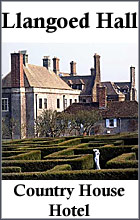|
Llŷswen (Llŷs-Wen) - From 'A Topographical Dictionary of Wales' (1849)
LLŶSWEN (LLŶS-WEN), a parish, in the union of Hay, hundred of Tàlgarth, county of Brecknock, South Wales, 7 miles (W. S. W.) from Hay, on the road to Builth; containing 172 inhabitants. This parish, the name of which implies "a fair palace," was anciently one of the residences of the native princes of South Wales. It comprises 1067 acres, whereof thirty-three are common or waste land. The village is situated on the river Wye, which is not navigable here; the neighbourhood is well wooded, and abounds with rich and beautifully picturesque scenery. The living is a discharged rectory, rated in the king's books at £3. 14. 7., and in the patronage of Joseph Bailey, Esq.: the tithes have been commuted for a rent-charge of £96. 4.; and there is a glebe of thirty-seven acres, valued at £88 per annum. The church is a small edifice, close to the bank of the Wye. There is a place of worship for Calvinistic Methodists; and two Sunday schools are held, one of them in connexion with the Established Church, and the other with the Calvinistic body.
Llangoed Castle is situated within the parish; the mansion was erected in 1632, which date, inscribed on a stone over the ancient doorway, is still remaining. The grounds are extensive, and comprehend some of the most attractive scenery in South Wales; and the surrounding eminences, some of which are very lofty, are clothed with stately and valuable timber to their summit. The river Wye, which here separates the counties of Brecknock and Radnor, skirts the demesne for nearly two miles and a half; it is sometimes hurried with impetuosity over its rocky channel, and at other times flows smoothly along its deeper bed, in some places more than forty feet in depth. The banks are richly planted with lofty trees, under which is a beautiful walk, extending through the grounds in a direction parallel with the course of the stream. The view from the church embraces a variety of scenery: to the east and south it extends over a fine tract of country towards Hay, including the village of Glâsbury, and the Black Mountains; to the north-west are seen the hills of Llangoed, ornamented with the finest forest-trees; and on the opposite bank of the Wye are the hills in the parishes of Boughrood and Llanstephan, Radnorshire. In the garden of an ornamental cottage near the church, is a tumulus, opposite to a remarkable horse-shoe bend of the river Wye.
|

